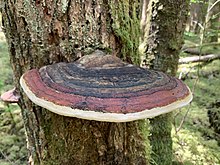Fomitopsis mounceae
Fomitopsis mounceae is a recently isolated species of shelf fungus. Originally thought to be identical to the red-belted conk, recent studies show that it is in fact a discrete species.[1] The original specimen was isolated from Edson, Alberta on a poplar tree.[1] This species was named after Irene Mounce, a respected Canadian mycologist.
| Fomitopsis mounceae | |
|---|---|
 | |
| Scientific classification | |
| Kingdom: | Fungi |
| Division: | Basidiomycota |
| Class: | Agaricomycetes |
| Order: | Polyporales |
| Family: | Fomitopsidaceae |
| Genus: | Fomitopsis |
| Species: | F. mounceae |
| Binomial name | |
| Fomitopsis mounceae Haight & Nakasone | |
It causes cubical brown rot typical of Fomitopsis, and favours aspen or coniferous trees. It is a detritivore, and does not typically grow on live trees. It typically grows at lower elevations than its close relative, F. schrenkii.
Description
Fomitopsis mounceae is a perennial woody conk distributed across Canada and the northern United States, down to northern California.[1] It is typically fan-like in shape, with distinct bands usually brown or red in colour.[1] It can have a resinous, sticky coating.[1] As the conks age, they often become bumpy or warty.[1] The underside of the conk is typically white or yellow in colour, with 3-6 round pores per millimetre.[1] If broken open, the inside is woody and brown, with no distinct bands.[1] It stains brown in KOH.
References
- Haight, John-Erich; Nakasone, Karen K.; Laursen, Gary A.; Redhead, Scott A.; Taylor, D. Lee; Glaeser, Jessie A. (2019-03-04). "Fomitopsis mounceae and F. schrenkii—two new species from North America in the F. pinicola complex". Mycologia. 111 (2): 339–357. doi:10.1080/00275514.2018.1564449. ISSN 0027-5514. PMID 30908115.